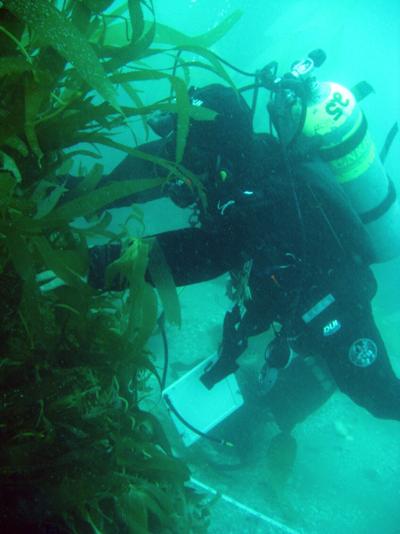The California Coastal Commission on March 13 unanimously approved a reduced monitoring setup for Southern California Edison’s mitigation reef coinciding with the San Onofre Nuclear Generating Station.
Following three consecutive years of the colloquially known Wheeler North Reef meeting all performance standards, CCC Executive Director Kate Huckelbridge recommended the commission determine the monitoring program should be scaled down.
The success of the WNR comes after the reef’s Phase III expansion that was completed in 2020, authorized by the CCC due to the reef’s inability to meet standards for fish standing stock and other discrepancies during the previous phase. Determined to be too small to meet performance standards, construction on WNR added 198 acres to the reef site for a total of a 373-acre property.
CCC Ecologist Rachel Pausch told the commission on March 13 that commission staff and independent scientists from the University of California, Santa Barbara—the latter of which are contracted to execute the field monitoring program—determined the necessary milestones had been reached to broach scaling down the program.
The WNR earns mitigation credit for one year by demonstrating similar performance to the Barn and San Mateo reference reefs across 11 relative performance standards and meeting other relative and absolute standards.
Relative performance standards, pertaining to data such as fish reproductive rates and macroalgal percent cover, are those that require the WNR perform similarly to reference sites each year. Absolute performance standards are pieces of data measured only at WNR that must be met each year.
In 2023, the reef met more standards than San Mateo, the lowest performing reef, marking the third straight year since the project’s expansion that the WNR has earned a credit and the fifth since 2019.
According to the CCC’s standards, the reef must accumulate at least 4,800 acres of giant kelp area and 896 tons of fish standing stock, of which the WNR has generated 229 acres and 129 tons, respectively.
“While this is an excellent trend and (shows) significant improvement of the performance of the reef compared to before the expansion, the reef still needs another 28 years of monitored and documented success meeting its performance standards for its required marine life mitigation to be fully satisfied,” said Pausch.
Through three consecutive successful years, the project has met the conditions of the Conditional Development Permit that allow for scaled-down monitoring, in which a public review of WNR can occur every five years or sooner if determined by the executive director. The reduced program stipulates sampling from 15 locations (transects) instead of the previous 82 for relative performance standards, and sampling from 111 transects for the absolute performance standards.
Additionally, other standards would be evaluated with fewer samples collected over a shorter period of time.
“Analyses of the data collected between 2012 and 2021 showed estimates of similarity based on full monitoring were similar to those estimates based on reduced monitoring,” Pausch said, adding to the rationale for reduced monitoring.
The City of San Clemente submitted a comment letter to the commission, according to Pausch,
questioning whether the reef has impacted beach erosion within South Orange County. Pausch said prepared environmental impact reports for the project stated past studies have shown low-relief kelp reefs do not have impact on long-period, low-frequency swell waves that affect beach sedimentation.
Staffers are still working with the city to provide documentation and address concerns, she added.
During the public-comment portion, Mandy Sackett, senior California policy coordinator for the Surfrider Foundation, stated the organization’s gratitude for the WNR’s improvement in performance. She also noted that the improvements came only after the reef had failed to meet performance standards in the years prior to expansion, adding that Surfrider would prefer to see continued monitoring at the original level and a sensitivity analysis.
“At a minimum, we would want to make sure that a mix of these areas that have met performance standards in the past and those that have not met performance standards in the past be included in this new plan, in order to avoid cherry-picking the best performing sites,” said Sackett.
In response, Huckelbridge said CCC staff and scientists worked intensely to determine how to reduce monitoring the best way possible and in a manner that they could easily identify when a return to full monitoring may be needed. UCSB scientist Dan Reed, who works as a research biologist for the project, agreed.
Reed added that the transects, or sections of the reef to be studied, were determined according to stratified random design and were designed to cover the WNR’s “broad spacial scale,” which were initially set up in pairs to facilitate diving.
“We’ve looked at the analyses and shown that the pairs are actually fairly close to each other; those pairs are only about 25 meters apart, but they’re 40-meter-long transects,” he said of the strategy for reduced monitoring. “What we’ve done is, we’ve eliminated one of those pairs, and we’ve reduced the number of transects but still covered the full extent of the reef.”
The executive director has the authority to find the reef’s success or failure to meet performance standards at any time, according to the executive director’s report.
More specifically, if staff determine the WNR failed to outperform either reference reef in seven or more of the 11 relative criteria, it would recommend a return to full monitoring. Staff would also do so if the reef fails five or six criteria in one year and continues to do so the following year.



